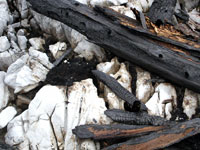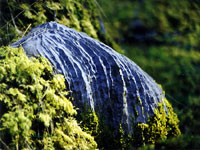Karst management and post-harvest operations (lesson 8)
On this page
- Learning objectives
- Introduction
- Issues and challenges
- Herbicides
- Mechanical operations – site preparation and vegetation management
- Burning
- Reforestation
- Stand tending
- Fertilizing
- Rehabilitating degraded features and sites
Learning objectives
This lesson discusses how the karst management principles you have been exploring can be applied to post-harvest operations. By working through this lesson you will be able to:
- Recognize the major challenges and issues involved with post-harvest operations on karst terrain
- Identify best management practices for post-harvest operations based on the vulnerability of the karst
Introduction
As you work through this lesson, you will understand how post-harvest operations can be modified to accommodate the vulnerability of a karst area. Post-harvest operations include:
- Herbicides
- Mechanical operations – site preparation and vegetation management
- Burning
- Reforestation
- Stand tending
- Fertilizing
- Rehabilitating degraded features and sites
Issues and challenges
What are some of the management issues associated with post-harvest operations on karst?
- Minimizing the impact of burning, particularly on karst with shallow organic soils
- Minimizing the impact of herbicides and fertilizers on karst groundwater systems
- Minimizing soil disturbance from mechanical methods of site preparation
- Minimizing the obstruction or clogging of karst features with spacing and pruning debris
Burning in a karst area should be carefully executed.

Herbicides
The following section summarizes the recommended best management practices for applying herbicides on karst terrain. Be sure to check out more detailed information in the Karst Management Handbook for British Columbia.
Low vulnerability areas
The following best management practices are recommended:
- Evaluate the potential for detrimental impacts on karst systems before using herbicides
- Select appropriate herbicides for the type of karst terrain being treated (for example, toxicity levels, chemical pathways, breakdown rates)
- Limit aerial applications of herbicides to karst areas with sufficiently thick soil and/or till cover to break down the herbicide before it can leach into karst groundwater and subsurface environments
Moderate vulnerability areas
In addition to the recommendations for low vulnerability areas, the following best management practice is recommended on moderate vulnerability areas:
- Keep herbicide applications well away from sinking and losing streams, surface karst features, cave entrances and exposed epikarst
High vulnerability areas
In addition to the recommendations for low and moderate vulnerability areas, the following best management practice is recommended on high vulnerability areas:
- Herbicides should not be used on high vulnerability areas. If herbicides must be used, employ ground spot treatments (for example, hack and squirt)
Mechanical operations – site preparation and vegetation management
The following section summarizes the recommended best management practices for mechanical operations – site preparation and vegetation management – on karst terrain. Be sure to check out more detailed information in the Karst Management Handbook for British Columbia.
Low and moderate vulnerability areas
The following best management practices are recommended:
- Keep the wheels or tracks of equipment at least 5 metres from the edge of karst features. If not possible, keep wheels or tracks parallel to the edge of features
- Avoid mechanical methods of site preparation and vegetation management on areas where soils overlying epikarst are thin
- Avoid pulling stumps during site preparation if significant soil erosion and/or soil transfer into epikarst cavities could occur
High vulnerability areas
In addition to the recommendations for low and moderate vulnerability areas, the following best management practice is recommended on high vulnerability areas:
- Mechanical forms of site preparation or vegetation management are inappropriate on high vulnerability karst areas
Burning
The following section summarizes the recommended best management practices for burning on karst terrain. Be sure to check out more detailed information in the Karst Management Handbook for British Columbia.
Low vulnerability areas
The following best management practice is recommended:
- Consider the potential impacts of burning on nearby or adjacent high vulnerability karst areas (for example, smoke entering significant caves can reduce air quality for cave fauna or recreationists, and discolour delicate formations such as stalactites)
Moderate vulnerability areas
In addition to the recommendations for low vulnerability areas, the following best management practices are recommended on moderate vulnerability areas:
- Limit burning to spot, small pile, or light spring broadcast burns in areas where the soil cover is sufficiently thick to protect underlying karst resources
- Use road prisms and/or landings for burning sites
- Avoid piling and burning slash on exposed epikarst, or near surface karst features or cave entrances.
- Avoid using chemical fire retardants/suppressants
- As an alternative to burning, consider accumulating and leaving slash in small piles located away from exposed epikarst, surface karst features and cave entrances
High vulnerability areas
In addition to the recommendations for low and moderate vulnerability areas, the following best management practice is recommended on high vulnerability areas:
- Broadcast burning should not occur on high vulnerability areas
Reforestation
The following section summarizes the best management practices for reforestation on karst terrain. Be sure to check out more detailed information in the Karst Management Handbook for British Columbia.
Best management practices for all vulnerability categories
The following best management practices are recommended:
- Ensure prompt reforestation after harvesting to help minimize brush problems and reduce the need for vegetation management
- Avoid major changes in tree species to maintain consistency in the forest type and litter biota, which can influence surface and subsurface karst processes
- Where required, use alternative stocking standards (for example, cluster planting) on areas with limited growing potential, such as exposed bedrock and outcrops
Stand tending
The following section summarizes the recommended best management practices for stand tending on karst terrain. Be sure to check out more detailed information in the Karst Management Handbook for British Columbia.
Best management practices for all vulnerability categories
The following best management practices are recommended:
- Advise stand tending crews of karst field assessment results, and give directions for carrying out stand tending operations
- If a karst field assessment has not been done, one should be completed to provide appropriate stand tending guidance
- Keep spacing and pruning debris clear of surface karst features, cave entrances, watercourses and established trails leading to surface karst features or caves
Fertilizing
The following section summarizes the recommended best management practice for fertilizing on karst terrain. Be sure to check out more detailed information in the Karst Management Handbook for British Columbia.
Best management practices for all vulnerability categories
The following best management practice is recommended:
- Avoid using aerial broadcast applications of fertilizers that could contaminate karst groundwater and subterranean environments/habitats. Consider using spot applications as an alternative
Rehabilitating degraded features and sites
The following section summarizes the recommended best management practices for rehabilitating degraded features and sites on karst terrain. Be sure to check out more detailed information in the Karst Management Handbook for British Columbia.
Best management practices for all vulnerability categories
The following best management practices are recommended:
- Evaluate degraded features or sites individually to determine if rehabilitation efforts would be successful or lead to more disturbance. Where more damage could result from rehabilitation efforts, avoid undertaking any action
- Rehabilitation efforts may include:
- stabilizing sinkhole sideslopes with grass seeding
- modifying tree planting where soil has been lost into epikarst cavities
- removing logging debris or windthrow from sinking streams, surface karst features and cave entrances.
- Use low ground-pressure equipment and rubber mats for recovering debris in or near sinkholes with unstable rims and sideslopes
- Keep the wheels or tracks of equipment at least 5 metres from the edge of karst features. If not possible, keep wheels or tracks parallel to the edge of features
Self check questions
Answer either True or False to check your understanding.
- Aerial applications of herbicides are appropriate on high vulnerability karst areas
- Avoid mechanical methods of site preparation on thin soils overlying epikarst
- Broadcast burning should not occur on high vulnerability karst areas
- Avoid major changes in tree species to maintain consistency in the forest type and litter biota, which can influence karst processes
- If a karst field assessment has not been done on an area, stand tending can still proceed
- Spot applications are a good way to avoid contaminating karst groundwater when applying fertilizers
- All karst features that have been degraded during forest operations should be rehabilitated
Self check answers
- False
- True
- True
- True
- False
- True
- False

